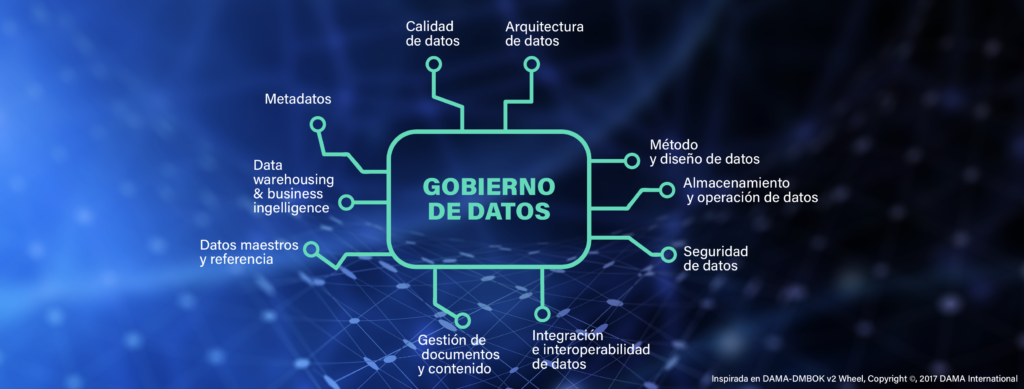How to implement data governance strategies: pain points and challenges to solve
The lack of alignment between data initiatives and strategic business objectives, along with resistance to cultural change and the existence of data silos that generate inconsistencies, are part of the main problems linked to data governance.
We can also identify as challenges the lack of clear roles and responsibilities, which can generate conflicts, and the low quality of data, which negatively impacts decision-making.
Another complexity associated with data governance lies in the difficulties that some organizations have in granting efficient access to data by their teams. Not to mention the integration of new technologies, the lack of clear metrics and the risks of regulatory non-compliance.
Another key problem to solve is scalability, due to the exponential growth in the volume of data that increases costs and makes it difficult to control.
Overcoming these challenges requires a combination of strategies that consider quality, security, agile access and cultural change, supported by a Flexible architecture aligned with organizational objectives.
Taking into account the current context, in this article we analyze the main pain points that organizations have in relation to the effective management of data and the creation of a data-driven culture.
We also explain how to implement a data governance strategy and what challenges need to be addressed in the future.
Data governance and data-driven culture
The two concepts we mention in this subtitle are essential for organizations to remain competitive in a dynamic environment oriented towards the intelligent use of data.
The data governance It is the set of policies, processes, standards and roles that ensure the efficient and secure management of data within an organization.
As explained by Roberto Álvarez Romero, Manager Data Architect at Deloitte Consulting, it is essential for a company know what data you have, where it is and how it is used. For this reason, a data management system such as data governance is necessary.
According to IBM, the objective of data governance is Maintain high-quality data that is secure and easily accessible to gain deeper business insights.
That is to say, ensure the quality, availability, integrity and security of data throughout its life cycle, from collection to use, storage and disposal.
Its key components are the policies and legal provisions that must be complied with, the quality standards and the roles linked to data governance management.
Likewise, access control and protection of sensitive data to prevent leaks or unauthorized use; along with monitoring and auditing of regulations and control of changes in data systems.
While its benefits lie in ensuring data quality for more accurate decisions, and minimizing risks related to cybersecurity and regulations, as well as aligning data use with the strategic objectives of the business.
Data governance provides the basis for developing a data-driven culture, as it ensures that data is reliable, secure and accessible to the entire organization.
Without strong governance, data-driven decisions can be flawed due to quality issues, inconsistencies, or regulatory non-compliance.

A data-driven culture refers to an organizational environment where Decisions and strategies are based primarily on data analysis, rather than intuition or subjective experience.
In this type of culture, data becomes a fundamental resource for innovation and growth. Its characteristics are the following:
- Democratic access to data.
- Decision makers trained in how to interpret data and apply advanced analytics.
- Use of analytical tools such as BI (Business Intelligence), Big Data and Machine Learning to extract insights.
- Indicator-based monitoring.
- Continuous improvement.
The benefits it provides are:
- agility to respond quickly to market changes;
- operational efficiency to improve processes;
- allows for the detection of emerging opportunities and encourages experimentation with lower risk;
- increases the accuracy of decision-making by basing it on objective and verifiable data.
A data-driven culture drives the adoption of governance practices, as it requires high-quality data and efficient access to information.
A high-impact multi-million dollar market
In addition to considering the negative implications of not having an adequate data governance strategy, or not having the capabilities and commitment to manage it properly, It is important to be clear about the market volume involved in this practice..
As we reported in our article Data Governance: objectives, principles and good practices for data management, the global data governance market size was valued at $3.66 billion in 2023.
By 2024, growth is projected to reach $4.44 billion, and a progression to $19.86 billion in 2032. The information comes from the Fortune Business Insights Market Report, which estimates a CAGR of 20.6% for the period 2024-2032.
According to the report, the volume of data is expected to reach 180 zettabytes by 2025, three times more than that generated in 2020.
It is also highlighted that organizations are promoting projects to extract maximum value from the data they collect, in order to make better decisions.
In this sense, the main benefit received by companies that develop data governance programs is the improvement in data quality and trust.
Key pain points in effective data management and creating a data-driven culture
Companies often face data silos, a lack of knowledge about where they are and who they depend on, poor quality, lack of management processes and difficulties in accessing relevant information.
This is how our partner analyzes it, Pablo Mlynkiewicz, Head of Data Governance at Data Governance Latam, CDO & co-founder of Kosmic Voice and Academic Coordinator of the Data Governance Diploma from the University of CEMA.
For the expert, creating a data-driven culture is a challenge, especially when business, product or marketing teams do not trust the data or do not have the necessary literacy to take advantage of it in strategic decision-making.
Indeed, organizations face several challenges in managing data effectively and in the process of creating a data-driven culture. Among the main pain points are:
Data quality and reliability
When there is incomplete, duplicate or incorrect data, or when there are no clear processes for cleaning and validation.
Information silos
It refers to organizations whose departments operate in isolation, making it difficult to access and share data. It also refers to the lack of centralized visibility of data for global decision-making.
Lack of adequate and accessible tools
In the case of companies that have insufficient technological infrastructure or that do not have the necessary updates.
Resistance to cultural change
Staff reluctance to adopt data-driven practices, due to inertia toward intuitive or traditional decisions.
A situation that can be compounded by the lack of incentives for teams to adopt a data-driven approach.
Lack of analytical skills
In some organizations, there may be a shortage of talent trained in data science, analytics, and visualization. This could lead to gaps in understanding key metrics and their impact on the business.
Security and privacy
The specific pain could be related to concerns about the secure handling of sensitive data, or the difficulty in complying with rules and regulations.
Defining and aligning metrics
Lack of clarity about which indicators are most relevant for each level of the organization. Or in the case of having goals and KPIs that are not aligned between different areas.
Insufficient data governance
Lack of clear policies for data management, ownership and control, and difficulty in defining clear roles and responsibilities around data management.
Scalability and maintenance
Data volumes are growing rapidly, creating scalability and performance issues, as well as high storage and processing costs.
Difficulty connecting data to business strategy
This problem is expressed in the lack of alignment between data initiatives and the company's strategic objectives. It also results in the frustration that arises when the insights generated are not translated into concrete actions.
How to govern data
Pablo Mlynkiewicz highlights that it is essential to define a data strategy aligned with the organization's objectives.
This includes establishing strong governance, identifying critical data, implementing quality processes, and empowering teams to use data effectively.
“Starting with small wins and building credibility helps to expand data culture. We often call it “eating the elephant piece by piece,” our partner points out.
From Microsoft Azure They point out that the first five recommended procedures for data governance are:
- Think big, but start small.
- Appoint a person to internally champion the company’s data governance strategy.
- Develop the business case for why an effective data governance plan needs to be implemented as soon as possible.
- Develop the right metrics.
- Communicate with all levels of the organization regarding this process, especially those who are resistant to change.

A comprehensive approach to managing data effectively
Undoubtedly, creating a data-driven culture and managing data effectively requires a 360-degree approach, addressing both technological and cultural and governance aspects.
To implement one the following steps can be considered:
1. Aligning data initiatives with business objectives to ensure relevance and return.
2. Determine priority use cases. You can start with high-impact projects, such as operational optimization or improving customer experience. For example, implementing predictive models to optimize inventories, if the business is looking for operational efficiency.
3. Designate a data lead to drive strategy and coordinate cross-departmental initiativesThe role of Chief Data Officer (CDO) must ensure the alignment between technology, processes and organizational culture. In parallel, form a multidisciplinary team with analysts and data engineering specialists.
4. Designing a data governance model, with clear policies and roles for data management, specifying who generates it, who uses it, and who controls it. It should also establish standards for data quality, integrity, and security.
5. Implement appropriate technology and tools. From our area of Data Innovation We focus on developing solutions that maximize the value of data and ensure its security and regulatory compliance.
6. Promoting a Data-Driven Culture with training in data analysis, dashboard interpretation and metrics-based decision making. Likewise, promoting the daily use of KPIs and data in meetings and reports.
7. Managing data quality from the start, with automated cleaning and validation processes, and rules that avoid duplications and inconsistencies between systems. In addition to monitoring with periodic audits.
8. Ensuring safety and regulatory compliance.
9. Monitor and adjust results with key metrics, and implement a continuous feedback system to adjust the strategy based on results.
10. Perform Quarterly progress reviews towards data-driven adoption.
11. Once initial solutions have been implemented, Expand initiatives to more areas or functions, and share successes as they occur to encourage adoption across the organization.
12. Promoting cultural change from senior management, to ensure that leaders are role models in data-driven decision making.
The path towards a data-driven organization is progressive and requires a constant commitment between technology, processes and culture.
Starting with a clear strategic vision, accompanied by strong data governance and training, is critical to ensuring effective and sustainable adoption.

Challenges to effective data management and creating a data-driven culture
“The biggest challenge is managing the exponential growth of data, ensuring its quality and security, and aligning it with increasingly strict regulations,” says Pablo.
“It is also key to foster a culture that evolves with new technologies, such as generative artificial intelligence, and to adapt teams to a more automated and agile environment,” he adds.
Among the main challenges that organizations will have to address are the following:
YO. He Exponential increase in data volume complicates its storage, processing and analysis. The solution is to implement scalable solutions and architectures that optimize costs and performance.
II. The Customer and user expectations for personalization are increasing, but must be balanced with compliance with privacy regulationsTo respond to this challenge and protect privacy, privacy by design approaches can be implemented, such as the use of anonymized data or federated learning techniques.
III. The integration of AI and Machine Learning It can be complex and generate internal resistance., in addition to requiring high-quality and well-structured data. In this regard, the data infrastructure can be improved and interdisciplinary teams can be formed to develop reliable models.
IV. The Lack of alignment between business areas and data teams can create friction and slow the adoption of data-driven practices. Involve leaders from the beginning and establish incentives that promote data use at all organizational levels.
V. Much of the data comes from unstructured sources (images, videos, text), which makes it difficult to analyze in real time.Given the growth of this type of data, advanced processing technologies such as NLP (Natural Language Processing) and video analysis tools can be implemented to extract value.
VI. Demand for data scientists, analysts and AI experts outstrips supply, limiting businesses’ ability to manage their data. Invest in programs internal training, develop alliances with educational institutions and promote strategies staff augmentation, allows to reduce the gap.
VII. Data protection regulations are evolving rapidly, creating non-compliance risks for organizations. Creating a specialized area for data compliance and adopting flexible frameworks that allow rapid adaptation to new regulations, favors compliance with current legal provisions.
VIII. Facilitate access to data without compromising security It is a key challenge to enable more employees to make decisions based on them.
Conclusion
Future challenges in data management and creating a data-driven culture are not limited to technological adoption, but rather include strategic, regulatory and cultural aspects.
The key is to combine a robust data strategy with ongoing training and strong governance to ensure that data is not only managed effectively but becomes the driving force behind decision-making across the organization.
Through our Data Studio we support you so that you can get the most out of the data generated by your operation, with cutting-edge technologies and tools. We invite you to learn about our proposal and connect with us

